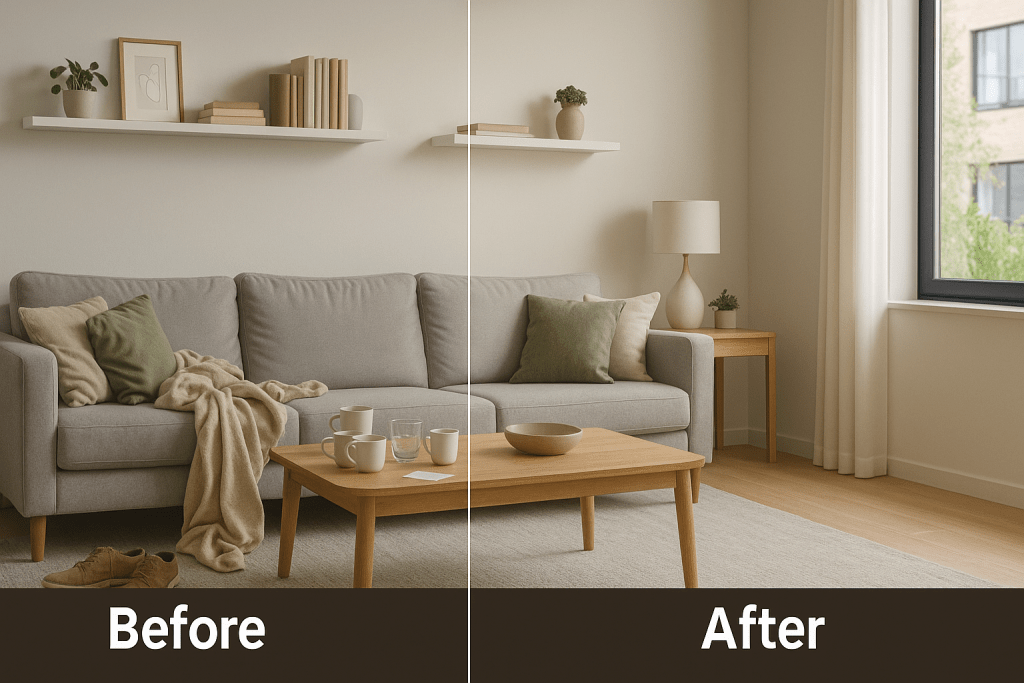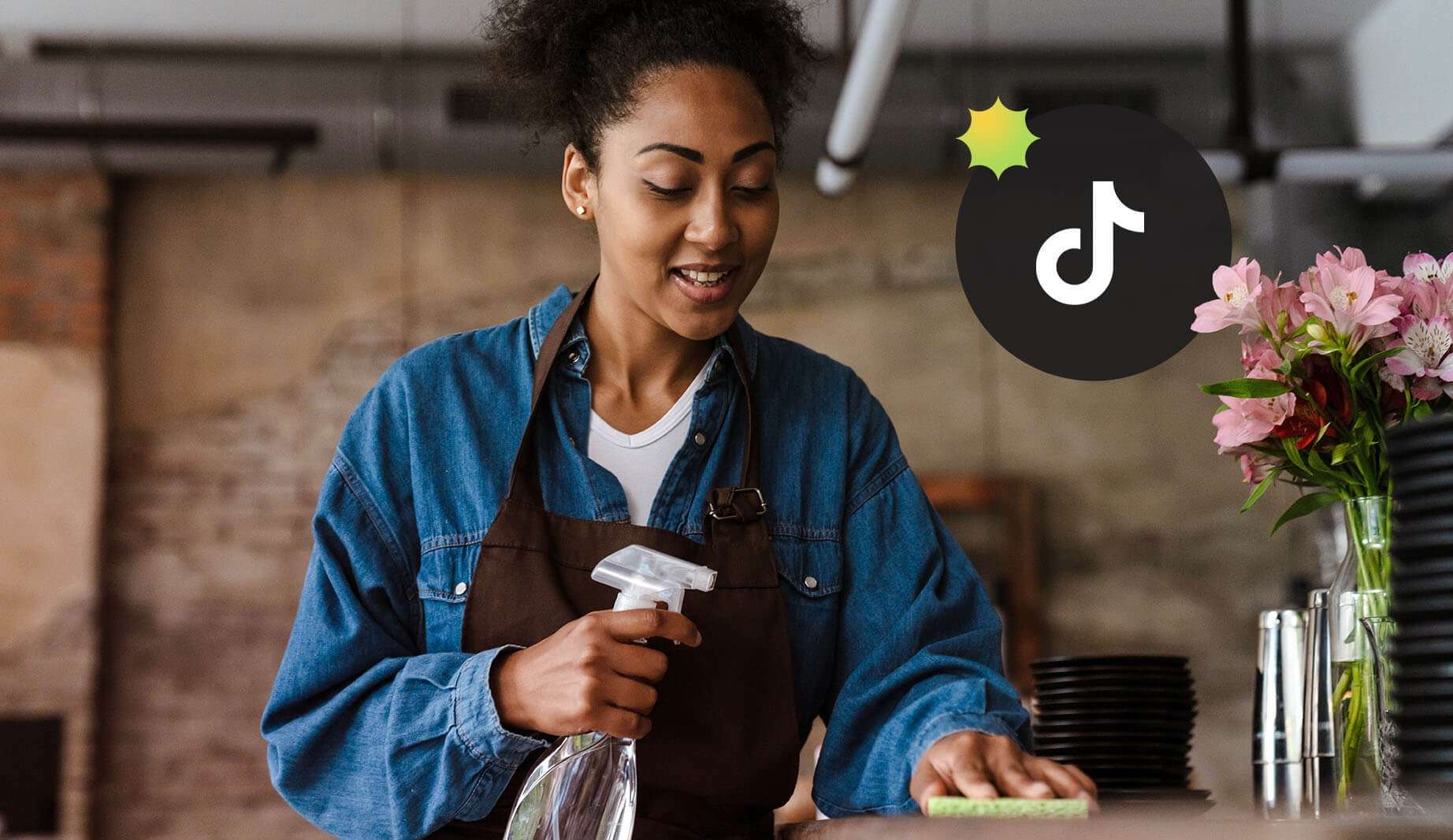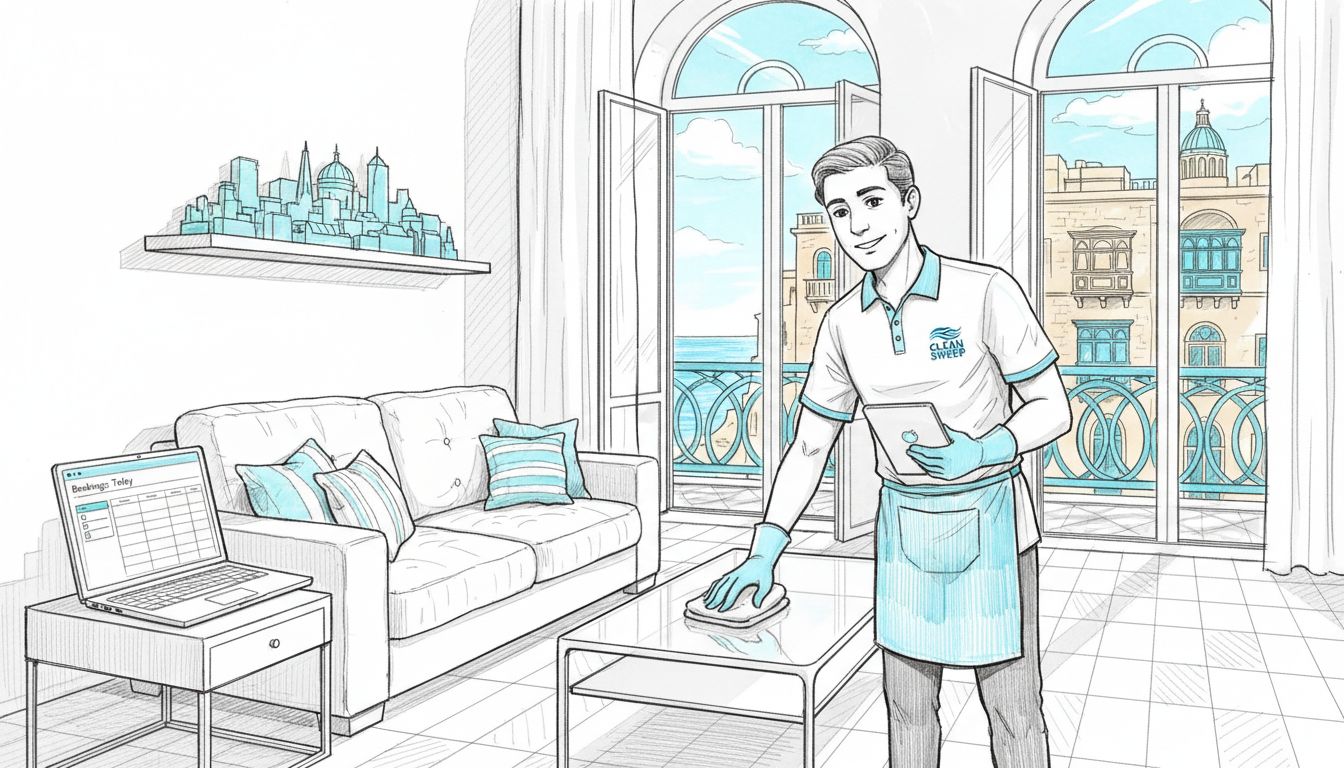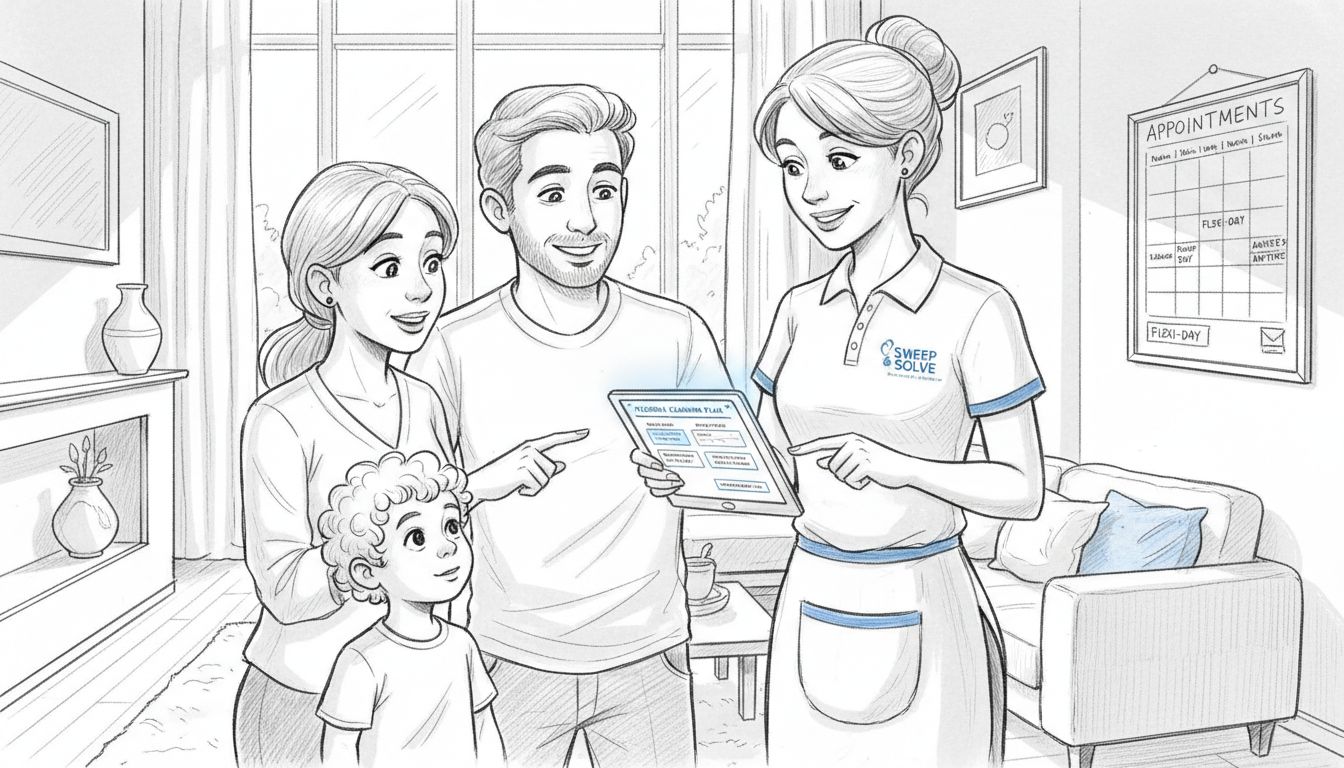A basket of home cleaning supplies ready to tackle any mess. The internet’s latest obsession with cleaning shows no signs of slowing down.
Cleaning Becomes a Social Media Sensation
Not long ago, house cleaning was a mundane chore we did behind closed doors. Now it’s prime entertainment. On TikTok and Instagram, satisfying cleaning videos and clever housekeeping hacks have exploded in popularity. The hashtag #CleanTok alone has racked up over 150 billion views as people watch influencers scrub sinks and sort clutter with hypnotic devotion. These “cleanfluencers” turn everyday chores into shareable content, posting viral tricks for making bathtubs sparkle or organizing pantries like mini department stores. In short, cleaning is on trend right now – a surprising cultural phenomenon turning the humble act of tidying up into something cool.
What’s driving this obsession? In part, it’s the oddly satisfying nature of transformation. A grimy stovetop becomes gleaming; a chaotic closet turns orderly. Viewers get a vicarious sense of accomplishment from each before-and-after reveal. Mental health experts note that watching someone turn a cluttered, chaotic space into a clean, harmonious environment can instill a comforting sense of calm and control. It’s like ASMR for neatness: the gentle swish of a broom or the white noise of a vacuum can be strangely soothing to frazzled nerve. In an anxious world, a spotless shelf or perfectly made bed offers a small island of order.
Social media also makes cleaning feel more communal and achievable. People from all walks of life – college students in studio apartments, busy moms in suburban homes, bachelors in city lofts – share their real-life messes and methods. Finding out that thousands of others also struggle with laundry pile-ups or mystery fridge odors can be validating. And if a 30-second time-lapse of someone else deep-cleaning their kitchen inspires you to finally tackle yours, all the better. The internet has essentially turned cleaning into a team sport, with everyone swapping tips to make the job easier or more fun. As one cleaning content creator noted, it’s joyful to see “people from all walks of life sharing their tips and how they get motivated to clean”. The result is a flood of new ideas – some ingenious, some admittedly just clickbait – on how to keep our living spaces tidy.
Why Are We So Obsessed with Cleaning Now?
The timing of this cleaning craze isn’t accidental. Experts point to a few big reasons behind the surge. First, after years of pandemic living and lockdowns, many of us became intimately familiar with our homes – and our homes’ many flaws. Kitchens doubled as offices, living rooms became gyms and classrooms. All that time indoors made a clean, comfortable environment more crucial (and more challenging) than ever. Even as life returns to normal, the heightened awareness of home hygiene and organization has stuck around. In a sense, cleaning became a form of self-care during stressful times, and it continues to be a coping mechanism for many.
Secondly, we live in an era of time scarcity. Between demanding jobs, family responsibilities, and the incessant ping of digital life, modern adults often feel there aren’t enough hours in the day. Psychologists say that clutter and mess can amplify stress – it’s hard to relax when yesterday’s dishes are still in the sink. So it makes sense that a generation feeling stretched thin would fixate on any tricks to streamline chores or reclaim a sense of order. A tidy home can offer a rare tangible accomplishment when so much else (work projects, life goals) feels never-ending. Even just watching cleaning content provides an instant hit of vicarious productivity (“Look, a disaster of a closet transformed in 60 seconds!”) without us having to lift a finger.
There’s also a deeper psychology at play. Cleaning offers control in a chaotic world. When news headlines or work deadlines feel overwhelming, scrubbing a countertop is refreshingly straightforward – you have power over that small domain. Some have likened the appeal of cleaning to meditation: focus on a simple physical task, and your racing thoughts might quiet down. The popularity of routines like the “Sunday reset” speaks to this need for control. This trending ritual involves dedicating a day (often Sunday) to do all the laundry, change the bedsheets, and clean the house top to bottom, essentially “resetting” your home for a fresh week. Devotees say it reduces anxiety and helps them feel back on top of things. Even the names of these trends – reset, refresh, clean slate – hint at the psychological relief they promise.
Meanwhile, the internet has reframed cleaning as something more inspiring than drudgery. We now have catchy challenges and hashtags that make tidying up feel like being part of a movement. For example, a viral method called the “closing shift” borrows its name from retail jobs and has taken TikTok by storm. The idea is simple: at day’s end, you pretend your home is a store about to close and do a final sweep of putting things away, wiping counters, and prepping for the next morning. In other words, get your home “ready for tomorrow” every night. Thousands have embraced this routine as a way to ease morning stress – there are fewer messes waiting to ambush you at 7 AM. Similarly, quick challenges like the 15-minute declutter (set a timer, tackle a junk drawer or clutter hotspot until it rings) appeal to busy folks by breaking cleaning into bite-sized, gameified tasks. These trends resonate because they acknowledge reality (we’re busy!) yet offer an achievable path to a cleaner space.
The Perfection Pressure – And Pushing Back
Like any social media trend, the cleaning craze has its dark side. Along with genuine tips and motivation can come a subtle pressure to live up to Instagram-worthy standards of spotless perfection. Influencers often film in picture-perfect homes with color-coordinated pantries and minimalistic, mess-free living rooms. After watching one too many “pantry makeover” montages, it’s easy to start feeling like everyone’s home is supposed to look like a curated photo shoot 24/7. One TikTok fan admitted she’d been spending hours each day watching cleaning videos – at first it was calming, but soon she felt a “nervous urge to continuously organize” her own home in response. Essentially, the endless parade of immaculate spaces was making her anxious about any mess in her life.
It’s an ironic flip side: content meant to relieve stress can, in excess, create new stress. Therapists warn that chasing an always-perfect home can be a futile and exhausting pursuit. Real homes are meant to be lived in, not immaculate showrooms. As one behavioral health expert wisely put it, “at the end of the day, a home is meant to be a place where we live, not just a showroom to keep spotless”. Social media may normalize perfectly organized closets and crumb-free kitchens, but remember that influencers have the luxury of staging scenes (often as part of their full-time job). The average person with a 9-to-5, kids, pets – i.e. actual life – will inevitably have some clutter and dust. And that’s okay. In fact, a brief internet frenzy in 2023 proved how refreshing a dose of reality can be: when a celebrity casually showed off her messy New York apartment (toys on the floor, clothes strewn about), audiences were shocked – and strangely relieved – to see a public figure’s home looking “actually like someone was living there”. The takeaway? We shouldn’t let Instagram set the benchmark for what a “good” home looks like.
Lately there’s been a gentle pushback against the perfectionism of CleanTok. Some creators are intentionally sharing “messy house tours” or confessionals about their unmade beds and junk closets to remind followers that it’s normal for a lived-in home to have a little chaos. The #CleanTok community itself is broadening to include these more honest snapshots. The goal is to inspire each other to clean when it’s helpful, not to provoke guilt. As viewers, we’re learning to take the useful ideas (say, a clever hack for cleaning oven racks) and leave the unrealistic expectations behind. After all, the point of cleaning is to make life more comfortable – not to win some imaginary spotless trophy.
Help for the Time-Starved: Cleaners, Gadgets, and Apps

Of course, even with all the tips and trends in the world, some days you simply can’t muster the time or energy to clean. And you’re not alone. Modern life is pushing people to seek outside help to keep their homes clean – and that itself is becoming a trend. Professional cleaning services are on the rise, especially among dual-income households and urban dwellers. In the past, hiring a house cleaner might have felt like a luxury or indulgence, but busy professionals and harried parents are reframing it as a practical solution for sanity and work-life balance. In fact, recent stats show that roughly 1 in 10 U.S. households already pays for help with housekeeping to cleaning companies or freelance cleaners. And demand is expected to skyrocket – the U.S. Department of Commerce predicts that up to 80% of two-income families will be using some form of house cleaning service in the next few years. That’s a striking number, but it reflects a real shift: rather than sacrifice rare free time to mop floors, many people are deciding it’s worth budgeting for a cleaner so they can spend those hours on family, rest, or other priorities.
There’s evidence that this trade-off can boost happiness, too. Social scientists have found that when people spend money to buy themselves more free time – for example, by outsourcing tedious chores like cleaning – they tend to be happier and less stressed. It makes sense: coming home to a freshly cleaned space, done by a trusted cleaner while you were at work, can feel like a gift to your future self. You’ve eliminated a source of friction (the dirty bathroom or overflowing laundry basket) without expending your own effort, essentially freeing up mental bandwidth. One study in the Proceedings of the National Academy of Sciences even linked buying time (like hiring house cleaners or grocery delivery) to greater life satisfaction, as it removes some of the “negative moments” from your day. The bottom line: if scrubbing the tub is weighing on you, there’s no shame in getting a little help.
How to choose: cleaning company, gadget or do it on your own?
It certainly helps that finding a cleaner is easier than ever thanks to technology. Just as Uber and DoorDash let us summon rides or meals on-demand, a wave of home cleaning apps promise to send vetted cleaners to your door with a few taps. Rozie.app, for instance, connects users with verified, trustworthy cleaning services professionals on an on-demand basis – essentially “book a cleaner like you’d order a pizza”. Need a last-minute cleaning before the in-laws visit? There’s likely an app for that. These services emphasize safety and reliability, often showing reviews and background-checked cleaners so you can feel comfortable even if you’re handing house keys to a stranger. The gig economy has truly entered the broom closet, and for many time-crunched people, that’s a welcome development. This is a new uber-like strategy for Rozie rather than conservative appreaoch of regular cleaning company.
Even if you’re not ready to hire a human cleaner, smart gadgets can shoulder some of the burden. The past few years have seen a boom in robotic vacuum cleaners (those little disc-shaped robots cheerfully roaming your floors), automated mops, and even AI-assisted tools that map your home and suggest cleaning schedules. Tech enthusiasts on CleanTok love to show off these devices – videos of a robot vacuum seamlessly sucking up yesterday’s cereal under the table can be oddly captivating. These AI-powered cleaning tools are touted for saving time and effort, letting you outsource the drudgery to a machine. While a Roomba won’t replace a thorough deep-clean, it can certainly keep the dust bunnies at bay in between your own cleaning sessions. And for many, that’s worth every penny.
Striking a Balance in the Era of Clean
Dusting off the day’s worries? Many find cleaning therapeutic, but experts warn not to chase perfection.
It’s clear that home cleaning has evolved from a private weekend task to a cultural talking point. We’re swapping cleaning tips on social media, turning chore time into “me time,” and even revolutionizing how we approach cleaning with new services and technology. For homeowners, renters, busy professionals, and families alike, the conversation has opened up: it’s okay to acknowledge that keeping a home clean is hard work. It’s okay to seek hacks and help. And it’s okay to admit you’re human and sometimes the mess wins.
Perhaps the greatest lesson of this cleaning craze is that a clean home isn’t an end in itself, but a means to something greater. We don’t scrub and organize just for the sake of it – we do it to live in a space that feels good, that supports our daily lives rather than hinders them. Whether you find joy in the process (putting on music and tackling a “Sunday reset”) or prefer to outsource the heavy lifting to a cleaning service, what matters is that your home works for you. As trends come and go, that core goal remains. So enjoy the oddly satisfying videos and try that new hack if it speaks to you. Embrace the convenience of a professional cleaner if it eases your load. But also give yourself grace on the days your house is less than perfect.
In the end, the real cleaning trend of 2025 isn’t about a specific mop or viral hashtag – it’s about the idea of treating our homes and ourselves with a bit more care and compassion. A clean home can boost your mood and free your mind, but it shouldn’t come at the expense of your well-being. So go ahead and join the cleaning revolution on your own terms. Take what’s useful, skip what’s not, and remember: the goal is a happier, healthier life, not just a cleaner house. And that’s something worth talking about. Read more articles about cleaning in our blog, for example more info about how to choose cleaning service or cleaning company.
Download Rozie:

Aleksandrs Tuls
| Author & Co-Founder, Rozie
Co-creator of Malta’s first on-demand cleaning app, Aleksandrs distils
real-world data into quick home-care hacks and business insights.
Featured in Yahoo Finance.
Connect on LinkedIn
.



